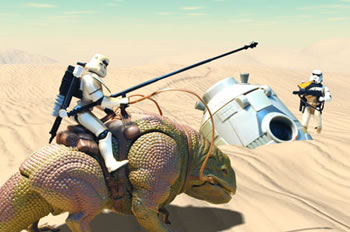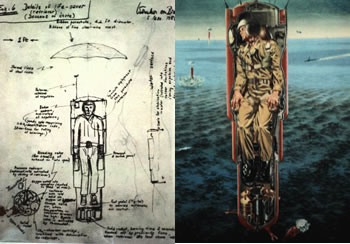Science Fiction
Dictionary
A B C D E F G H I J K L M N O P Q R S T U V W X Y Z
Space Rescue Technology In Fact And Fiction

NASA is preparing a backup shuttle and rescue crew in case shuttle Discovery has problems in May. Rescue flights have been become more of an issue since shuttle Columbia broke up in reentry two years ago. Space shuttle commander Steve Lindsey states "Our emphasis on return to flight is getting the tank fixed and the tools in place to inspect to make sure that we don't have damage -- and if we do have damage, to hopefully repair it. This [rescue mission] would be a last resort. Hopefully, we will never see this."
Emergency rescue capabilities will be limited to missions to the space station to retrieve stranded astronauts; other scenarios have been studied, but none have been trained for.
Scientists and science fiction athors have been thinking about emergency rescues in space for almost as long as they have thought about voyages in space. In his 1938 novel Triplanetary, E.E. "Doc" Smith wrote about emergency lifeboats:
Smith also wrote about an ablative heat shield in the same book (which was very similar to an actual escape pod concept called an "airmat"). In 1941, author Harry Walton wrote about a rescue ship - he called it a "lifeship" - in Moon of Exile. In 1946, Arthur C. Clarke published his first short story, titled Rescue Party, in which aliens on a survey mission arrived to try to evacuate humanity from Spaceship Earth in the face of the sun going nova:
"We are approaching a sun which is about to become a nova. There are ten planets, with a civilization on the third. It is our tragic mission to contact that doomed race, and if possible save some of its members."
The crew rescue vehicle that most movie-goers are familiar with is of course the escape pod in George Lucas' Star Wars. It offered room for several crew members (or droids); R2 programs the pod's course.
Artoo was already working his way into the cramped boat pod. It was just large enough to hold several humans, and its design was not laid out to accommodate mechanicals. Artoo had some trouble negotiating the awkward little compartment.
"Hey," a startled Threepio called, admonishing, "you're not permitted in there..."
...the three armored forms darted away toward their only hope of escape - an emergency lifeboat that could be launched through the shell of the great globe.
(Read more about emergency lifeboats)
Alveron read the message from base: then, with a flick of a tentacle that no human eye could have followed, he pressed the General Attention button...
"You've led us through half the ship, and to what...?"[Threepio] broke off, staring in disbelief as the squat robot reached up with one clawed limb and snapped the seal on a lifeboat hatch...
(Read more about the Star Wars escape pod)

(Star Wars Episode IV Escape Pod)
Update 19-Sep-2019: See also these references, the escapecraft from The Ethical Equations (1945) by Murray Leinster, the emergency space-boat from Revolt of the Star Men (1932) by Raymond Z. Gallun, the survival bubble from Footfall (1985) by Niven & Pournelle, the life tubes from Salvage in Space (1933) by Jack Williamson, the life ship from The Invisible World by Ed Earl Repp and the emergency lifeboats from Triplanetary (1934) by 'Doc' Smith. End update..
Scientists and engineers have, of course, also considered this problem. Werner Von Braun pushed the idea of a manned space station in the 1960's; with it he also designed a protective ejection type capsule. A parachute with steel-wire mesh reinforcements and solid rocket booster would break the fall; antenna and radar beacon activate automatically.

(From Von Braun Rescue Vehicles)
After the 1986 shuttle Challenger accident, NASA started seriously looking at alternatives for the Space Station. Some proposals even included the use of refurbished Apollo lunar capsules from the 1960's. The only completed crew rescue capability ever provided by NASA is the Apollo CSM rescue craft. A kit was created to fit out an Apollo command module with five crew couches; in the event that a Skylab crew ran into trouble, a rescue CSM would be launched to rendezvous with the station.
This capability was created partly in response to the sci-fi movie Marooned, released in 1969, starring Gregory Peck, David Janssen and Gene Hackman (among many others). The movie explored what happens when a problem develops in space and astronauts are stranded.

(From NASA Rescue CSM craft)
During the last decade, NASA developed the X-38 prototype, which was intended as an emergency vehicle for up to seven crewmembers on the International Space Station. It would have been carried up to the ISS by shuttle, and attached to a docking port. The craft offered a seven hour life support system, a steerable parafoil parachute deployed at 40,000 feet to carry it through to landing. It was intended to have fully automated navigation and control systems. This program has been cancelled.

(From NASA X-38)
Read more at NASA readies possible space rescue.
Scroll down for more stories in the same category. (Story submitted 2/1/2005)
Follow this kind of news @Technovelgy.| Email | RSS | Blog It | Stumble | del.icio.us | Digg | Reddit |
Would
you like to contribute a story tip?
It's easy:
Get the URL of the story, and the related sf author, and add
it here.
Comment/Join discussion ( 3 )
Related News Stories - (" Space Tech ")
Will Space Stations Have Large Interior Spaces Again?
'They filed clumsily into the battleroom, like children in a swimming pool for the first time, clinging to the handholds along the side.' - Orson Scott Card, 1985.
Reflect Orbital Offers 'Sunlight on Demand' And Light Pollution
'I don't have to tell you about the seven two-mile-diameter orbital mirrors...'
Chrysalis Generation Ship to Alpha Centauri
'This was their world, their planet —
this swift-traveling, yet seemingly moveless vessel.' - Nat Schachner, 1934
The First Space Warship For Space Force
'Each of the electrical ships carried about twenty men...' - Garrett P. Serviss, 1898.
Technovelgy (that's tech-novel-gee!) is devoted to the creative science inventions and ideas of sf authors. Look for the Invention Category that interests you, the Glossary, the Invention Timeline, or see what's New.
Science Fiction
Timeline
1600-1899
1900-1939
1940's 1950's
1960's 1970's
1980's 1990's
2000's 2010's
Current News
Jetson ONE Air Races Begin, Can Air Polo Be Far Behind?
'If you're one of those rarities who haven't attended a rocket-polo "carnage", let me tell you it's a colorful affair.'
Will Space Stations Have Large Interior Spaces Again?
'They filed clumsily into the battleroom, like children in a swimming pool for the first time, clinging to the handholds along the side.'
Mornine Sales Robot
'Robot-salesmen were everywhere, gesturing...'
Bipedal Robot Floats Gently While Walking
'a walking balloon proceeded with long strides of its aluminum legs...'
Musk Idea Of Cars Talking To Each Other Predicted 70 Years Ago
'My cars talk to one another.'
Elegant Bivouac Shelter Produces Water And Electricity
'There was nowhere on the planet where science and technology could not provide one with a comfortable home...'
X-Control Janus-1 A Suitcase Aircraft
'You will notice that it... fits the suitcase nicely.'
'AI Assistants' Are Actually Less Reliable For News
'Most men updated their PIP on New Year's Day...'
YES!! Remote Teleoperated Robots predicted by Technovelgy!
'...a misshapen, many-tentacled thing about twice the size of a man.'
Will Robots Ever Fold Landry?
Where have you gone, Mrs. Robinson?
Will AIs Give Better Results If You're Rude To Them?
'I said, "Listen up, motherf*cker.'
Cybertruck Robotic Arm F10 Drone Launch!
Drone away!
Black Fungus Blocks Radiation
'You were surrounded by Astrophage most of the time'
Liuzhi Process Now In Use In China
'He was in a high-ceilinged windowless cell with walls of glittering white porcelain.'
Reflect Orbital Offers 'Sunlight on Demand' And Light Pollution
'I don't have to tell you about the seven two-mile-diameter orbital mirrors...'
Will Robots Become Family Caregivers?
'The robant and the tiny old woman entered the control room slowly...'
